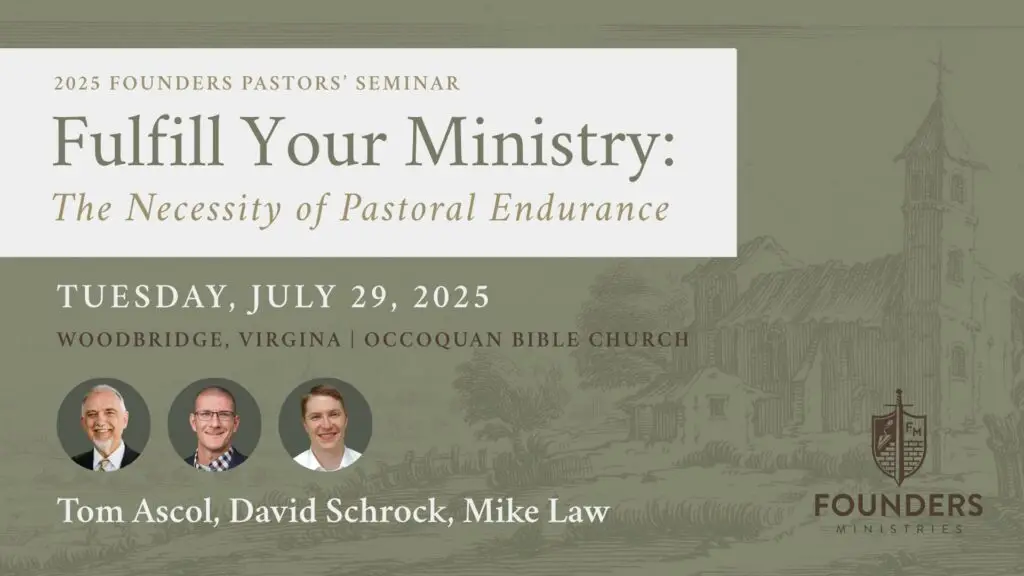In Romans 6:1-14, the Apostle Paul gives Christians, among other things, one of the purposes of believer’s baptism. This blessed ordinance of our Lord Jesus Christ is a beautiful picture worth a thousand words! While much ink has been spilled over the mode, subject, and purpose of baptism, let me give you three simple, yet profound pictures, that this ordinance gives the church.
First, it displays for us an:
Overwhelming Covenant
In Romans 6:14 we see that believers are not under law, but grace. Consider those two words there: “law” and “grace.”
The Apostle Paul is one of my favorite Baptists. And what we see him articulating for us here are the two great covenants of the Bible: The covenant of works and the covenant of grace.
This is how your Bible is divided. Old Testament and New Testament. This comes from the Latin Testamentum and just means covenant. Literally your Bible is divided into two sections known as Old Covenant and New Covenant, or, Law and Grace.
Now, this doesn’t mean there’s only law in the Old Testament and only Grace in the New Testament. Of course, that’s not true at all. But what it does help us see is that these two covenants, Law and Grace, help set the framework for the whole Bible.
In fact, I would go so far as to say that without understanding these covenants well, we do not read our Bibles well. Listen to how Spurgeon put it:
The doctrine of the divine covenant lies at the root of all true theology. It has been said that he who well understands the distinction between the covenant of works and the covenant of grace is a master of divinity. I am persuaded that most of the mistakes which men make concerning the doctrines of Scripture are based upon fundamental errors with regard to the covenants of law and of grace.
The Covenant of Works
So, in our text we have law and grace. All persons born in Adam are born into law, that is, under a covenant of works, a covenant that has been broken because of Adam’s sin (cf. Romans 5:12).
Adam is what we call our legal representative. He is the federal head of the human race. And in Adam, all die. We are born under a broken covenant of works and held guilty due to Adam’s sin all the while the moment we are able we choose volitionally to sin and rebel against our holy God.
It is our nature to sin and run away from God. We have nothing left within us willing or able to do any spiritual good before God.
Being under the law as a covenant of works, leaves us in a hopeless condition. It shows us the perfection God demands but only moves us to rebel (see Romans 7) and is unable to remedy our situation. What then is left for us to do? Well, all we can do, and all we want to do, only heaps up more condemnation.
The Covenant of Grace
This brings us to the overwhelming covenant and by that, I mean the covenant of grace.
In eternity past the triune Godhead agreed to save an unworthy people for His own glory. This agreement theologians call the covenant of redemption. But this is enacted in time by the promise of grace. We see this in Gen. 3:15 after the Fall: God will send the seed of the woman to crush the serpent’s head.
That same language is used again in Genesis 12: This Redeemer will be the Seed of Abraham and then later the offspring of David.
These promises, and so many more, point us forward to the covenant of grace which is inaugurated in Christ – Jesus is the One promised of old. He is the one in time, born of the Virgin Mary, fulfilling all righteousness in His life, dying the death of covenant breakers, bearing the wrath of God for His ppl, and rising again in victory over death, hell, and the grave.
The covenant of grace says there is nothing you can do in and of yourself to reconcile you to God. Not your going to church or taking the Lord’s Supper or reciting the Bible or prayers or creeds.
In and of yourself is only unrighteousness and sin.
But the Lord Jesus came. He completed the work. Where Adam failed, where Israel failed, where you have failed, He fulfilled all righteousness. He substituted Himself in our place. He bore the wrath of breaking God’s law upon the wooden cross. He rose again in triumph.
And God’s grace brings us out from under the law and places us within the new covenant, the covenant of grace (Romans 6:14).
Members of the Covenant
Under the law, the sign of the covenant of works was circumcision. It was a reminder that those who did not keep the whole law would be cut off from God. That is, the children of Abraham were not part of the covenant of grace unless, they, by faith, looked to the coming Messiah.
The true people of God have always and only been believers. It is only those who by grace alone place their faith alone in Christ alone who are God’s true Israel (cf. Rom. 9:6, Gal. 6:16). Someone’s physical birth or ethnicity does not bring them into the New Covenant.
In Romans 4:16 we see that Abraham is the true father of only those of faith, whether Jew or Gentile. Only those of faith are the ppl of God. Only those of faith are brought into the New Covenant, the Covenant of Grace.
Those in the Covenant of Grace are no longer under Adam as their representative. Rather, Christ represents them! They have died in Christ and now live again in Him having His righteousness credited to their account by grace alone through faith alone in Christ alone.
And, so, what is the sign, then, of this new covenant? This overwhelming covenant of grace? It is believers Baptism as Paul lays our in Romans 6:3-4.
This, of course, teaches us that Biblical Baptism is not for unbelievers. It is not for infants. It is only for those who have been brought into the New Covenant, dying to sin and self and rising again to newness of life as typified in Baptism which serves as a sign for God’s glorious grace upon a person’s life.
Baptism is a picture worth 1,000 words! Baptism signifies, it is a picture of, our union with Christ. It shows forth our newness of life. It publicly identifies us with the death and resurrection of Christ. Baptism does not perform these things. It does not create within us a new heart. It does not bring us into union with Christ.
Rather, it displays on the outside what God, in His sovereign grace, has already performed on the inside.
This is why we baptize by immersion (cf. Romans 6:3-4). Now, to say we “baptize by immersion” is like saying we “drink a drink.” Baptism and immersion are the same word. Baptism is really a made-up word in the sense that it’s just transliterated, brought straight over form Greek to English.
You can read John Dagg’s work on this Greek word but let me give you one quote from 17th Century Baptist, Henry Lawrence (1600-1664) who says: “the word Βαπτίζω signifies properly…to drowne, or sinke in the water, to dip, to overwhelme…”
You cannot signify the death and resurrection of Christ or the new believer by sprinkling water or by pouring water. Baptists baptize. That is, we immerse believers’ whole body down into the water and back up again.
Baptism, then, reminds us of an Overwhelming Covenant.
2ndly, it is a picture of an:
Obligatory Commitment
I love this quote from Sam Renihan: “Baptism is…a two-way declaration. On the one hand, it is God’s visible promise that all who are in His Son are new creations by virtue of their union with Christ in His death and resurrection. And on the other hand, it is the individual’s profession of faith in those very promises.”
Romans 6 shows us that by committing to the ordinance of baptism the new Christian is publicly declaring his or her death to sin and new life in Christ. He or she is declaring a commitment to follow Christ no matter the cost. The old man or woman has passed away and the new one has come being created anew in Christ Jesus by God’s grace.
In Baptism we have symbolized taking off the old man and putting on the new and now it is our fight every day to continue to do this. Every day we continue to mortify the deeds of the flesh. We continue to look to Christ and seek to walk in newness of life.
And this really is Paul’s argument in Romans 6:1-4. What he is encouraging the Roman Christians with is to, essentially, remember their baptism as a way of fighting sin in the present.
Let me put it to you this way: In many places in America there are people who profess to be Christians. And one of the reasons many say they are Christians is because they have been baptized.
Thus, they look to their baptism as a trophy rather than as a flag. Let me illustrate it like this: In the movie the Patriot, Benjamin Martin’s oldest son, Gabriel Martin, is continually sewing an American Flag . And even in the midst of despair and defeat, that flag is a symbol of what they are fighting for in the American Revolution.
And looking at the flag is what sort of turns the battle at the end of the movie.
Well, in a similar way, we look to our Baptism to remember what we are fighting for. We have died to sin and risen with Christ! This fight is worth it. Keep pressing on. You are dead to sin and alive in Christ. Christ is King. He is King of your Life. Keep up the fight.
If you look at Baptism as a trophy you just say, “Well, I’ve got my ticket into heaven and it doesn’t matter how I live.” If you remembering your baptism means you just live a life of unchecked rebellion and sin but you’re clinging to your baptism as your hope, you are foolish. This is not the purpose of Baptism.
But for those who have been born again, our Baptism serves as a reminder of who we are so that we can continue our growth in the Lord Jesus Christ. Being in the New Covenant does not produce passivity or carelessness but commitment to holiness.
Baptism is an obligatory commitment. It is our commitment before others that we are following Christ no matter the cost. He is worthy!
And by obligatory, I mean what my friend Jeffrey Johnson writes:
Although baptism is not essential to salvation, it is highly unlikely that a person has been truly born again without an eager desire to follow the Lord in this first command that God gives the new Christian. Baptism is a public confession of Christ that evidences to the church and the world that there has been a radical transformation within. Baptism is also a visible sermon. It demonstrates a spiritual reality of one’s death to sin and resurrection to the newness of life in Christ Jesus.
So, Baptism reminds us of an overwhelming covenant. It is an obligatory commitment. And finally, Baptism is an:
Open Commemoration
In Romans 6:3 Paul uses the phrase “all of us”. Paul is able to speak to the Church at Rome with the common understanding that Baptism was ordinary part of the Christian life.
That is, “all of us” were baptized. All of who? All Christians. Not that Baptism is what “makes” a Christian, but Baptism is what, in essence, publicly commemorates one as a Christian.
This is why Baptism is an ordinance of the local church. The local church has the keys of the kingdom from Christ Her Lord (cf. Matthew 16:19). And it is her duty to open the door to Baptism as it were for all who repent and believe the gospel.
So, when a local church baptizes someone, it is saying, in essence, “We receive this man or woman as a brother or sister in Christ.” In Baptism, the church is publicly declaring a person as a Christian.
Thus, in Baptism, the local church is committing to love this man or woman as a brother or sister in Christ, to watch over him or her in the Lord, to hold this person accountable in the Lord, and to humbly have him or her watch over us and hold fellow church members accountable as well.
Baptism is an open commemoration. It is not to be done in a secret closet unbeknownst to anyone else. It is not to be done on a whim in someone’s backyard separated from the local church.
Baptism is a local church ordinance where we perform this great event in the midst of the gathered church. That may be at a lake or in a river or even in a pool, but the point is, it’s properly done when the local church is gathered under the leadership of her pastors.
Fred Malone reminds us,
Away with the individualistic ecclesiology plaguing America which minimizes baptism and church membership, leaving Christians the freedom to float around without feeling responsible to a pastor or a church. Such an attitude feeds the antinomian spirit we see growing today. Yet, the whole teaching of the NT is that Christians need the ministry of a committed body of believers (church membership) which baptism calls them to. Church membership is required after baptism and believer’s baptism is required for church membership.
Thus, Baptism is an open commemoration. It is a public ordinance of the church whereby those baptized as well as the local church celebrate Christ together even as they mutually pledge themselves to one another in grace.
Fred Malone also states: “Baptism is the outward sign of entrance into the New Covenant by the inward circumcision of the heart, evidenced by one’s confession of faith in Christ.”
This reminds us that Baptism is a picture worth a thousand words. It cannot save in the sense of effecting regeneration or faith or justification or any such thing. Rather, it points us to Christ and is a picture of new life in Him (cf. Rom. 6:1-4).





























